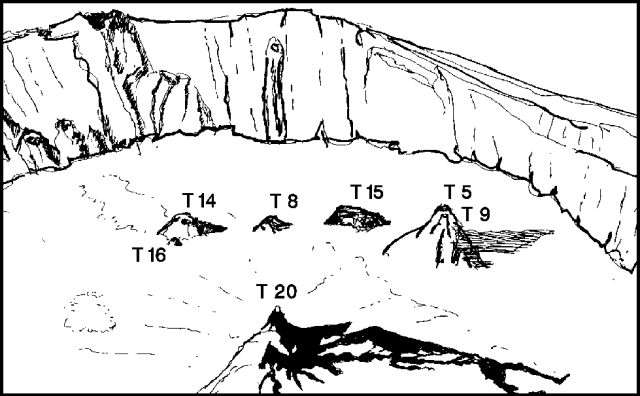Report on Ol Doinyo Lengai (Tanzania) — July 1992
Bulletin of the Global Volcanism Network, vol. 17, no. 7 (July 1992)
Managing Editor: Lindsay McClelland.
Ol Doinyo Lengai (Tanzania) Fluid lava from summit-crater vents; gas and temperature data
Please cite this report as:
Global Volcanism Program, 1992. Report on Ol Doinyo Lengai (Tanzania) (McClelland, L., ed.). Bulletin of the Global Volcanism Network, 17:7. Smithsonian Institution. https://doi.org/10.5479/si.GVP.BGVN199207-222120
Ol Doinyo Lengai
Tanzania
2.764°S, 35.914°E; summit elev. 2962 m
All times are local (unless otherwise noted)
During a 24-hour visit to the crater on 16-17 July by members of Geo-découverte and SVG, no lava emission was observed. However, the brownish color of some small lava flows from hornito T20 (figure 25) suggested that they were very recent. Magma was seen bubbling and splashing from small conduits in the bottom of T20, 3 m below the rim. During the night, a faint dull-red glow from the lava was visible. The level of the activity was irregular; sometimes the inner bottom of T20 was partially covered by lava, while at other times splashing noises could be heard but no lava was visible. Continuous vapor emission occurred only from the biggest (T5/T9) of the six hornitos on the crater floor.
Geologists sampled thermal features in the crater and conducted three overflights during the following week. Temperatures of 70-170°C were recorded in the hornitos on the crater floor, and reached 70-90°C under the solid crust of sulfur sublimates on the N rim. The 170°C maximum temperature was measured at hornito T15, where an iron tube was inserted. Gas was collected, at a temperature of 145°C inside the tube. A caustic soda bottle was used to sample H2O, CO2, total sulfur, chlorine, fluorine, and non-condensable gases. Samples were also taken containing AgNO3 and NH3 for sulfur species determination, and others for analyses of dry gases, inert gases, and isotopes. Impregnated and carbon-coated filters were used for collection within the plume and of sublimates on the ground. Fresh and older lava from the active hornito were collected. Pictures and 16-mm movies were taken during the overflights (on 18, 21, and 24 July). A lava flow was observed extending N from the central active hornito on 24 July.
Geological Summary. The symmetrical Ol Doinyo Lengai is the only volcano known to have erupted carbonatite tephras and lavas in historical time. The prominent stratovolcano, known to the Maasai as "The Mountain of God," rises abruptly above the broad plain south of Lake Natron in the Gregory Rift Valley. The cone-building stage ended about 15,000 years ago and was followed by periodic ejection of natrocarbonatitic and nephelinite tephra during the Holocene. Historical eruptions have consisted of smaller tephra ejections and emission of numerous natrocarbonatitic lava flows on the floor of the summit crater and occasionally down the upper flanks. The depth and morphology of the northern crater have changed dramatically during the course of historical eruptions, ranging from steep crater walls about 200 m deep in the mid-20th century to shallow platforms mostly filling the crater. Long-term lava effusion in the summit crater beginning in 1983 had by the turn of the century mostly filled the northern crater; by late 1998 lava had begun overflowing the crater rim.
Information Contacts: F. LeGuern, CNRS, France; M. Pennini, Istituto de Geocronologia, Italy; F. Emmi and L. Mansfeld, Etna Trekking, Italy; I. Munro, Executive Wilderness Prog, Nairobi; L. Cantamessa, Geo-découverte, Switzerland; F. Cruchon, S. Haefeli, W. Tribolet, and P. Vetsch, SVG, Switzerland.


